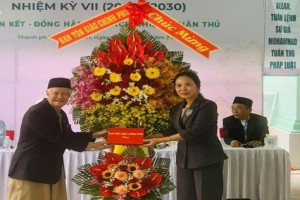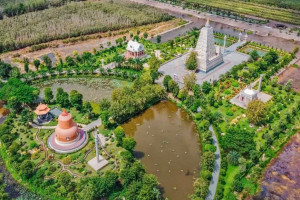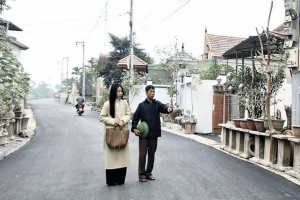
Islam in Vietnam is practiced mostly by Chăm ethnic-minority people, most of whom live in Hồ Chí Minh City and Southern provinces, such as Ninh Thuận, Bình Thuận, An Giang, Tây Ninh, and Đồng Nai.
According to historical documents, the Chăm people familiarized themselves with Islam during the tenth and eleventh centuries. Documents from China’s Tống (Song) Dynasty recorded the introduction of Islam into the Chăm Chiêm Thành Kingdom at the end of the tenth century and the beginning of eleventh century. However, only after Islam became popular among the Chăm people in Vietnam, the historic events in the fifteenth century followed by the decline of the Chăm Chiêm Thành Empire.
Such factors as geographical conditions, circumstance surrounding diffusion of the religion, living conditions, and the extent of communication with the outside world contributed to the formation of two main groups of Vietnamese Muslims: One is the Chăm Muslims in Ninh Thuận and Bình Thuận provinces, who are known as the Old Islamic Group or Chăm Bà-ni; the other is Muslims in Châu Đốc (An Giang), Hồ Chí Minh City, and Tây Ninh and Đồng Nai provinces in Southern Vietnam. They are known as the New Islamic Group, and their religion is known as Chăm Islam.
There are considerable differences between the two groups in terms of religious practices, religious scriptures and dogma, and especially in terms of rules and rituals. The main differences can be summarized as follows:
Chăm Ba-ni in Ninh Thuận and Bình Thuận provinces has been strongly influenced by local, traditional customs and beliefs and has mixed with elements of Brahmanism and matriarchy.
Chăm Islam in Châu Đốc (An Giang), Hồ Chí Minh City, and Tây Ninh and Đồng Nai provinces is different in that Islamic rules and rituals are fully observed. In particular, followers of this branch of Muslims maintain contact with the wider Islamic world through pilgrimages to Mecca. They send believers to Malaysia, Indonesia, and Saudi Arabia to study, and to organize annual ceremonies to chant the Koran...
One should mention the influence by Malaysians and Malay Islam on Chăm Islam in Vietnam. Although there are only a few Malaysians in Châu Đốc and even though they have been assimilated by the Chăm, this group nevertheless has exerted a rather large influence in many areas, ranging from social structure to religious activities to the spirituality of local inhabitants. Previously, in that area, the Koran was read in Arabic but was then taught in Malay. Most of the clerics who teach the Koran are Malaysians. Religious publications are also imported from Malaysia.
In 1991, the Muslims in Hồ Chí Minh City established a seven-member Muslim Community Representative Committee, which has a four-year term. From 1992 until now, the Hồ Chí Minh City Muslim Community Representative Committee has completed three terms: The first term from 1992 to 1996, the second from 1996 to 2000, the third term from 2000 to 2006, and the fourth term from 2007 to 2012. At the beginning of 2004, the Muslims in An Giang Province established their Preparatory Committee and organized a Representative Congress at the end of 2004, resulting in the foundation of An Giang Muslim Community Representative Committee.
Although there are not many followers of Islam in Vietnam, the religion is closely aligned with the Chăm people, an ethnic group with distinctive historical and cultural characteristics. Islam as practiced by the Chăm people has many variations; the religion has contributed to the diversity of culture and customs among Vietnam’s Chăm people as well as to Vietnam’s multi-ethnic cultural diversity.




